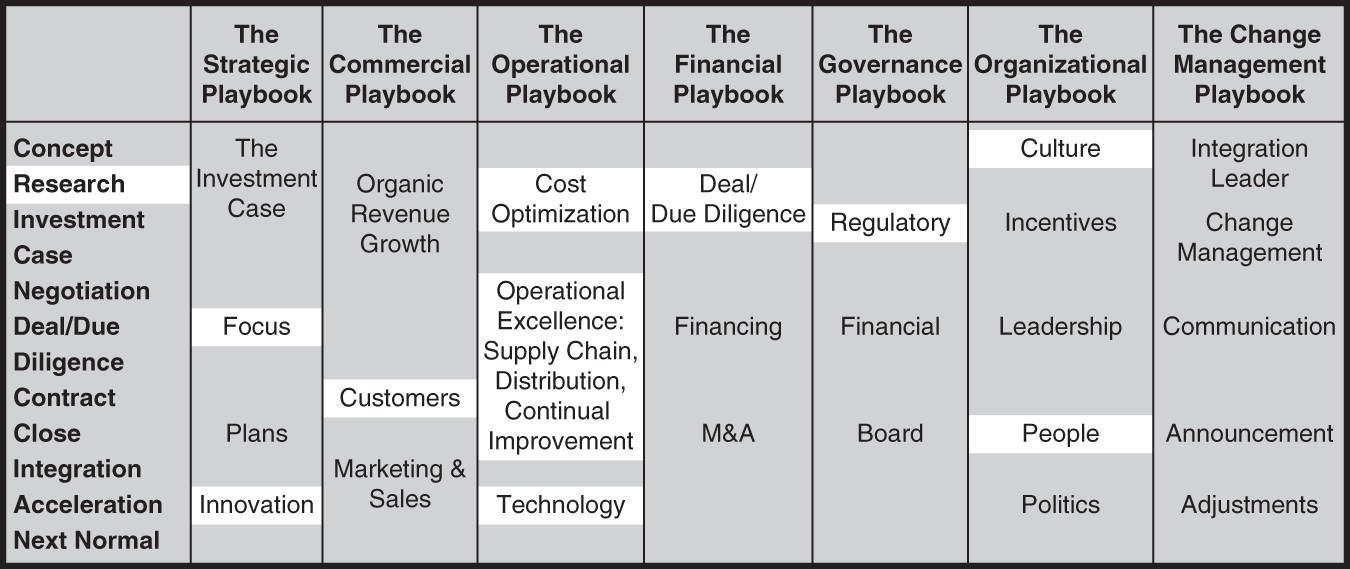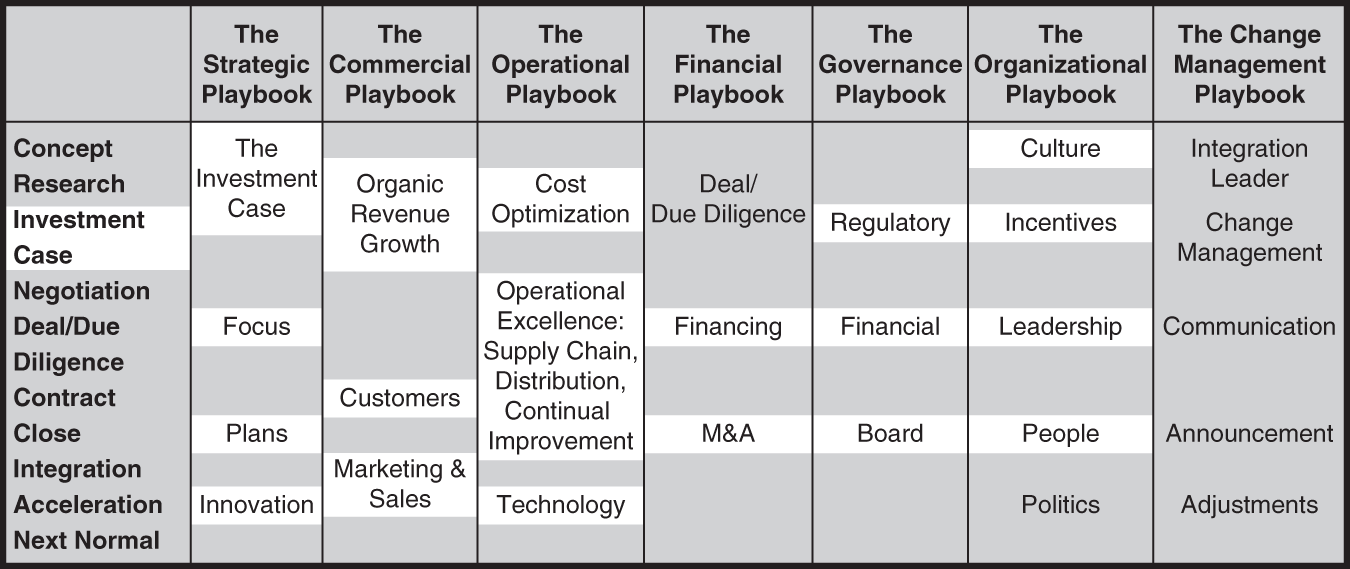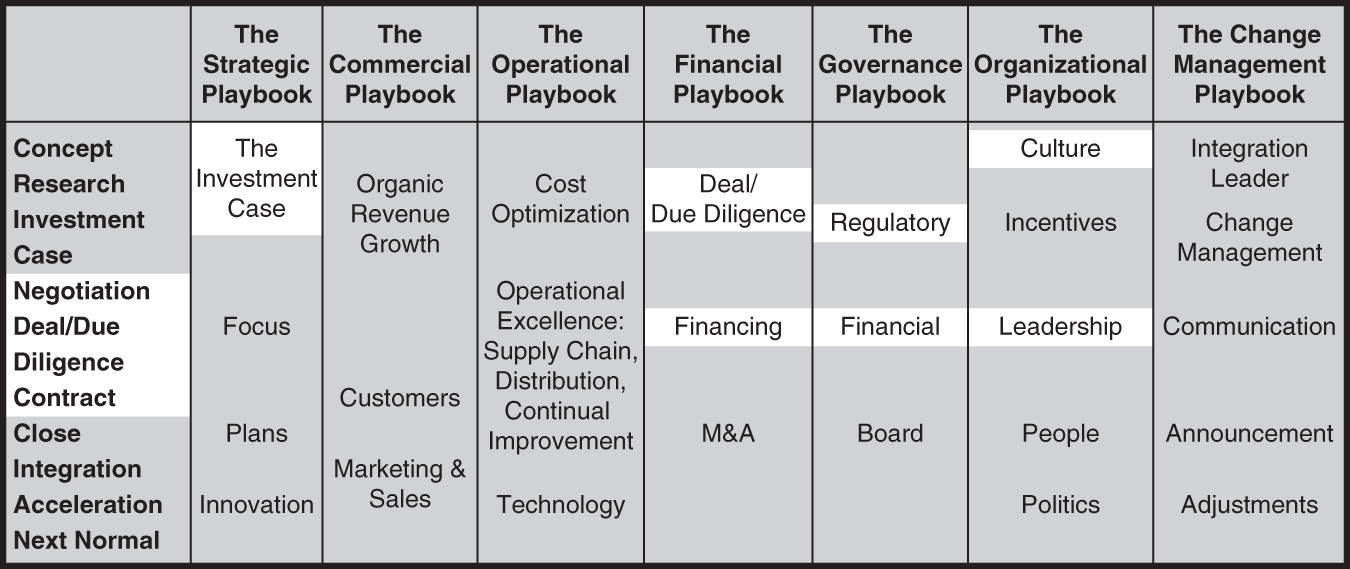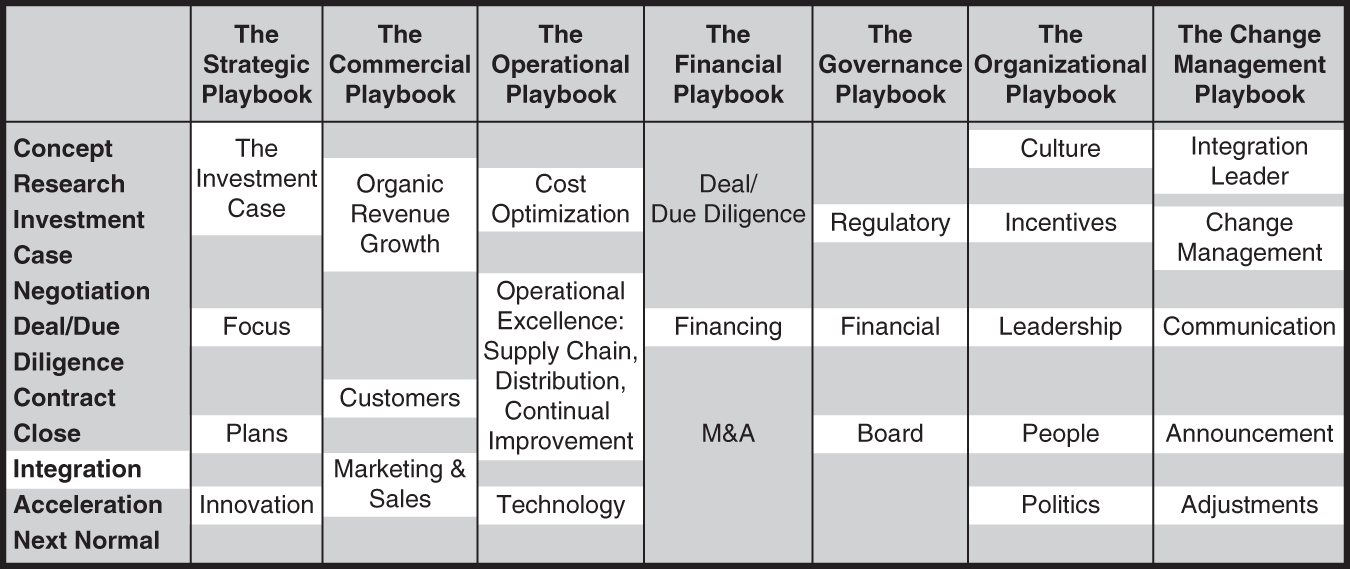CHAPTER 27
Prototypical Order
Parts of the seven different playbooks need to be deployed at different times in different mergers or acquisitions. Here's one prototypical chronology.
Prototypical Chronology: An Example
Concept
Start with the strategic playbook and tie the strategic plan into the investment case. Your initial concept need not be any more than vaguely right and include early thinking on where you might play and how you might win—focus. Be thinking in terms of customers, people and capabilities, and costs even at the concept stage. Keep a close eye on the competitors, disruptive technologies, and emerging trends.

Research
As you do your initial research, look for potential targets with the right customers, people, capabilities and culture, and cost optimization opportunities. Look for evidence of strengths in innovation, technology, and operations. And pay attention to the regulatory environment.

You may find the following tools helpful here:
3.1 Situation Analysis Checklist
3.2 SWOT
11.1 Culture
Investment Case
The investment case is where you dig in

You may find the following tools helpful here:
1.1 Investment Case
3.1 Situation Analysis Checklist
3.2 SWOT
3.3 Business Planning
4.1 BRAVE Innovation
7.1 Purchase/Sales Funnel Management
7.2 Marketing Planning
11.1 Culture
Negotiation, Deal, Due Diligence, Contract
Here's where the chronology becomes a myth. Ideally, you'd negotiate, do a deal, do some due diligence, and then lock your contract. In the real world, expect to move back and forth between the steps in anything but a linear fashion. Certainly, the investment case, financing, finances, and regulatory considerations will come into play. At the same time, if you're negotiating with people you're going to be working with going forward, pay attention to how you're building relationships with them as part of your future leadership and culture. You can't be one person during negotiations and then another after the deal is done.

You may find the following tools helpful here:
1.1 Investment Case
11.2 Negotiating
Close
The world changes and resets at the close.
Pre-close mandatories are getting your financing in place and regulatory clearance.
You're going to be much better off if you have:
- Stood up your board
- Prepared to go with the early parts of your financial playbook—like paying employees and providing stay incentives to the key players you can't lose yet
- Stood up an integration leader, transformation office, or PMO and thought through your change management approach
- Some current best thinking on the future culture
- Thought through your communication plan and started an announcement cascade
And if possible—which it won't be in many cases—you can accelerate things if you have:
- Selected the leadership team; and
- Co-created some of the aforementioned with them even before the close.
In any case, be mindful of the politics and know that every person's only question is, “What does this mean for me?”

Integration
We wrote this book to help you bring sense to the complexities of integration.

You may find the following tools helpful here:
19.1 Team and People Assessment
20.1 Future Organizational Capability Planning
20.2 Talent Management
20.3 Recruiting Brief
23.1 Alignment Workshop
Acceleration
A quick look at the difference between the integration and acceleration stages indicates you can stop worrying about financing and start thinking about future M&A. True. But that underplays the importance of staying focused on all the big and little things you and your team have to do to realize the investment case. Don't blink. This is a marathon, not a sprint.

You may find the following tools helpful here:
23.2 Change Management
24.1 Communication Planning
25.1 Announcement Cascade
26.1 Management Cadence
Next Normal
This book is your playbook to create value leading through a merger or acquisition. For whom? It could be for you or the current owners in the form of dividends. It could be for a strategic buyer as a way to complement their business strengths. It could be for an economic buyer as a platform for future value creation by them.
In the latter cases you essentially want to flip the investment case and build the case for others strategically, organizationally, and operationally.
Strategically
Build a track record of sustainable organic revenue growth, and paint a picture of where future organic revenue growth will come from in terms of
- A new product pipeline
- Servicing the customers
- Innovation pipeline and track record
- Pricing upside
- New channels
- New geographies
Separately, build a record of successfully integrating other mergers and acquisitions, and paint a picture of where future mergers and acquisitions could come from.
Organizationally
Build a “buyable” management team. This means a high-performing team capable of managing at least another doubling of revenue.
Build capabilities valuable to potential investors. This, in turn, may look like
- Product development capabilities in a design-focused organization
- Manufacturing black belts in a production-focused organization
- Ecosystem enrollers in a distribution-focused organization
- Customer experience experts in a service-focused organization
Operationally
Put in place a buyable infrastructure:
- Assets
- Data
- IT systems
- Financial reporting
- Processes
Personally
If you're part of the leadership team, make yourself invaluable to the next owners by doing the job the organization needs you to do the way the organization needs you to do it.
